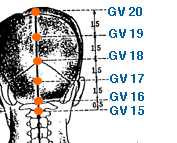GV 16 GV16 Wind Mansion Feng Fu 風府 governing vessel 16 Governing Vessel 16 gv16
GV 16 GV16
GV 16 GV16
GV 16 Wind Mansion - Feng Fu - 風府

Location
1 cun directly above the midpoint of the PHL, directly below the occipital protuberance on the posterior midline of the head.
Associations
- Window of the Sky Point
- Sea of Marrow Point (with GV 20)
- Ghost Point
- Intersecting Point of the Governing Vessel, Yang Wei Vessel & Urinary Bladder Channel
Actions
- Main point for wind, whether exterior or interior, particularly affecting the head and neck. For wind cold headache, stiff neck, aversion to wind; as well as dizziness, visual dizziness, numbness, twitching, tremors.
- Window of the Sky point, promotes communication between the head and body, many indications are consistient with other points of this group, such as headache, dizziness, throat swelling, earache, eye pain, nosebleeds, aphasia.
- Psychological issues such as mania, palpitations from fear a/or fright, suicidal thoughts.
- Tong Ren/Tam Healing System: Used to effect the medulla function (breathing issues, asthma, tight chest, etc.), but GV 17 is used more frequently, useful in spinal cord issues.
GV 16 Cautions
Precautions:
- No Moxa (MX): Cautions with moxa.
- No Deep Needle (NDN): No Deep Needling.
For a more comprehensive list of all cautions, see our precautions and contraindications page.
Relationships
Point Categories (3)
Nearby Points (2)
- EX Huatuojiaji at C1 Sides of Spine at C1
- UB 10 Celestial Pillar
Tong Ren Treatment Protocols (1)